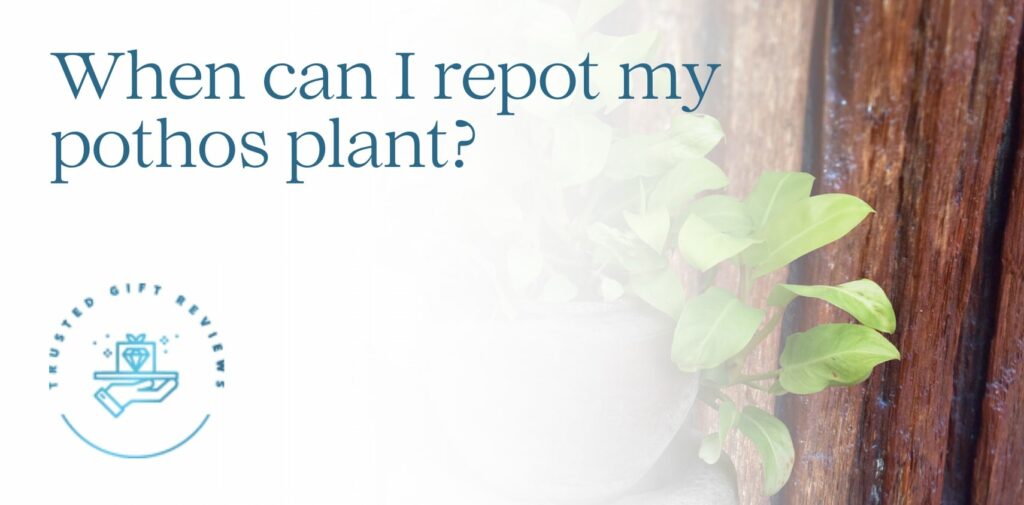Like all plants, repotting your pothos vines should be performed in the warm spring and summer months.
The reason is that these are when the plant is most actively growing and absorbing nutrients, so it will find adapting to its new pot vessel and environment easier.
Also, if you live in a region with a temperate climate (one that’s neither very warm nor cold), pothos can even be repotted in the late summer or early autumn.
Continue reading this guide to know why repotting pothos is essential, how to do it, the best potting mix to use, and more!
Why should I repot my pothos?


All plant species, including the pothos, need to be repotted for these reasons:
1) It has outgrown its pot container
The pothos cannot grow comfortably and fully in a container that’s too small for them. The right pot size is 2 inches larger than the pothos’ root ball or existing pot.
If it’s not repotted soon, the soil will dry out too fast and the roots will come out on the topsoil or from one of the drainage holes.
If still the container isn’t changed for quite a while, then the plant will be entirely root-bound (have tangled and dense roots) and its growth will be stunted.
And don’t just check the root size of the pothos but the leaves and tendrils too. See if they’re becoming too large or long for their home.
If this is the case, you might just want to move them to a different spot, but repotting the plant is often the solution for this.
2) It’s suffering from plant disease
Repotting enables the plant to survive if it’s suffering from disease, for instance, root damage, mold disease, or pest infestation.
These diseases come with one or more symptoms such as yellowing or drooping leaves that should help to identify the problem.
These outward signs should prompt you to reduce your watering on the pothos, give it fertilizer, repot it, or do other remediation.
3) You’re planning to change its pot for a more stylish one
Deciding to change the worn or damaged pot will require you to repot the pothos as well.
In the course of doing so, it’s also advisable to replace 1/3 or more of the potting soil, because chances are the nutrients in them have already been used up by the pothos.
As a result, you will have a nice decorative container and fresh potting soil for the pothos plant, making it more attractive in your house or garden!
How do I repot my pothos plants?


Here’s how you can repot your pothos plants:
- Take out the pothos from its pot
First, you need to take out the pothos from its container. Don’t pull the plant forcefully, as this will harm its roots and stems.
Instead, slowly tip the pot to the side and then slide the plant out. To prevent the soil from scattering to the floor or a surface, use a rubber spatula to manage it.
- Get the new pot ready
Get your new and clean pot and fill it with 1 or 2 inches of soil. This creates a separation between the roots and the bottom of the pot.
- Place the pothos in the new pot
Set the pothos vine in the center of the new pot. Add some soil around the sides to secure it, but leave roughly 2 inches of space to allow the pothos room to grow.
Bear in mind to not overfill the plant with soil to allow air and water to flow through it toward the roots.
- Water the pothos plant
Finish the process by watering the pothos plant 2 to 3 inches deep. This will establish it securely in the soil.
But after that, if the pothos seems to be lacking in soil, you can give it a bit more on the top.
What kind of pot should I place my pothos in?


Your chosen pothos pot must have drainage holes at the bottom. A soaked-through soil will harm the pothos plant, affecting its growth and root structure.
Aside from that, any pot will do so long as it is 2 inches larger than the root ball to give it ample space to develop and grow into an attractive climbing vine.
Putting the plant in hanging baskets or trellises is a brilliant idea to show off its graceful and long line of leaves. An ordinary pot from where they’ll climb upward or outward will also do.
What potting soil or mix should I use for my pothos?


Pothos plants are not choosy when it comes to potting soil or mix. Even so, they thrive in organic and fertile soil within a very low acid pH range of 6.1 to 6.8.
Standard Potting Soil
Here’s a standard potting soil recipe for your pothos:
- 2 parts potting soil with organic matter
- 1 part peat moss
- 1 part perlite
With only three ingredients, this recipe is very easy to make.
The potting soil must be amended with organic matter or aged manure. Doing so will benefit the plant in many ways, like enhanced nutrient exchange and drainage.
Also, peat moss will soften the soil structure, promote drainage, and retain moisture and nutrients, and perlite will greatly help with storing moisture and letting the water drain out of the soil at a moderate rate.
Soil-less Potting Mix
Here’s a wonderful soil-less recipe for your pothos:
- 10 parts coconut fiber
- 5 parts perlite
- 4 parts shredded bark or vermiculite
- 1 part compost
Using a soil-less recipe is great because it’s likely free from pests, bacteria, and diseases, and you can have better control mixing it to achieve the perfect soil attributes.
You may add other soil amendments if you want to increase the pothos’ drainage, aeration, or nutrient absorption.
Commercial Soil
If you’re thinking of just obtaining the soil from a store, we strongly recommend the Miracle-Gro Indoor Potting Mix, as it suits a large variety of container plants and is resistant to gnats.
But if you’re thinking of saving cash, then try the Hoffman Organic Cactus and Succulent Mix. Just add to it a part of peat moss and some compost to help the soil store enough minerals and water to flourish.
How often should I repot my pothos?


For the pothos roots and leaves to grow continuously without space hindrance, it’s usually best to transfer it over to a new pot at least once a year.
We stress the importance of doing it during the growing season. Anytime during the summer and spring would be good for these plants.
How do I care for my pothos plant?


Here’s how to take care of the pothos plant:
Sunlight
Locate the pothos in the direction of bright filtered light. Low-to-medium sun exposure will be endured by this plant, though it won’t grow as vigorously.
Don’t put them outside or near the window when the sun is intensely bright and hot because this will scorch the pothos’ leaves.
Water
Pothos are fairly drought-tolerant and can be watered once or twice each week. But make sure that the top 50 percent of the soil has dried out first before watering it.
Note that you’d have to hydrate the pothos plant more often in hotter seasons than in cooler times.
Temperature and Moisture
Hardy and adaptive like the snake plant, pothos can grow amidst various environmental conditions.
It’s best to put them somewhere with an ambient temperature between 70℉ to 90℉ and a moisture level of more than 60 percent.
Fertilizer
So that the pothos will develop lush and healthy foliage, you should feed it with fertilizer regularly.
For best results, use a balanced fertilizer with equal amounts of nitrogen, phosphorus, and potassium. Look for one with a 10-10-10 or 20-20-20 NPK ratio in garden stores or flower shops.
Pruning
Pruning the pothos vine is sometimes needed to make it look neater and shorter or produce more leaves.
Snip a portion of the plant below a node to trim the pothos. Meanwhile, if you want to encourage new stems and more leaves to grow, cut close to the crown (the part where the roots meet the stem).
Propagation
Below is how you can breed new pothos from its mother plant:
- Place the stem cuttings in a glass or jar filled with water.
- Situate it in a spot where it gets bright, indirect light.
- Wait for the roots to show after a month or so.
- Transfer it to a nice pot with a potting mix.
Pest and Diseases
- Pothos Pests
If not cared for rightly, pothos plants can be afflicted by certain pests and diseases, leading to weakness, wilting, and/or death.
Harmful pothos pests include spider mites, thrips, mealybugs, whiteflies, and gnats. They can seriously damage the plant tissues or suck the juice out of the plant.
As soon as you discover these insects, spray the leaves with water or neem oil to control or eliminate them.
However, it’s often best to just throw away the diseased plant quickly so the pest won’t get a chance to spread to other nearby leaves.
- Pothos Diseases
The two most common diseases for pothos are root rot and bacterial wilt, although the plants are far less likely to be affected by them than by pests.
Root rot is most often caused by neglect and overwatering. Fortunately, repotting the pothos can save its life and eventually allow it to recover and thrive.
On the other hand, bacterial wilt is brought about by the Ralstonia solanacearum bacteria observed in commercial pothos.
This disease is threatening and contagious. Thus, we advise disinfecting, bagging, and disposing of the infected plant or its parts to prevent bacteria from spreading elsewhere.




